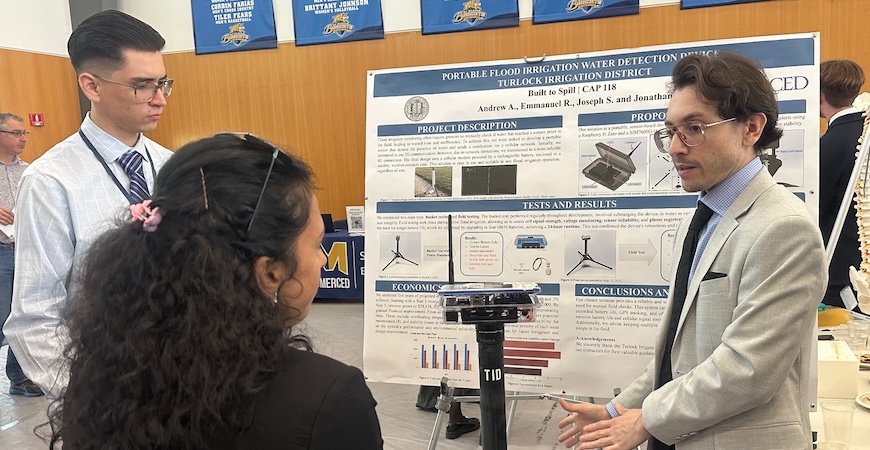
Imagine you're a farmer who uses a drip irrigation system on your crops. On watering day, you open the valve from the canal, then go to your orchard, maybe a few acres away, and wait. Once enough water arrives, you walk back and shut the valve. But that takes a long time and wastes water, a precious commodity in the northern San Joaquin Valley.
The Turlock Irrigation District, which supplies water to more than 4,000 farmers, wanted to help them increase their efficiency, and save time and money. So, like other companies from California and around the world, they turned to engineering students at UC Merced.
Each semester, teams of engineering and computer science students tackle thorny issues like these, coming up with solutions to real-world problems posed by clients. It might be developing a new app, or engineering a process to inspect train tracks virtually, or designing a foundation for a new building.
At the end of the semester, the teams present their projects to judges in a competition called Innovate to Grow, or I2G.
The team assigned to the Turlock district built a sensor to detect water. But it does more than that.
"It will send a text to the user," said Joseph Sanchez, a fourth-year mechanical engineering student on the team. "You can stand next to the valve and then know when to turn it off."
And it works. The team tested their sensor in an alfalfa field and "it worked perfectly," Sanchez said.
For their efforts, the team won the Ag Tech award in the Engineering Capstone at Innovate to Grow.
The other award winners were:
Lakireddy Software Award: Full Rack. Working for startup Owligator, team members Gustavo Castaneda-Lagunas, Ishita Prakash, Serena Chan, Srikar Gudipati and Victor Vargas developed a web application that uses machine vision to monitor wine racks through a live camera feed, making wine management faster, simpler and scalable.
Lakireddy Engineering Award: Seal Team Five. Team members Alan Kuang, Constantino Montenegro, Gordon Mui, Jose Vasquez-Reyes and Ryan Lee, working for Ingomar Packing Company, wanted to solve a problem with aluminum seals stamped onto tomato products. The lids frequently stick together. The team designed, developed and built a semi-automated system that separates, verifies and places individual foil seals into designated slots for packaging. If multiple lids are detected, an air knife system diverts them into a waste pile.
Software Engineering Capstone
Alan Turing Award: The Bart Simpsons Team. Members Anvita Kisara, Anika Potu, Harsha Krishnaswamy, Josh Estrada and Kanishka Verose designed and built a cloud-based track inspection tool to detect broken or missing coverboards across the Bay Area Rapid Transit system network.
Ada Lovelace Award: Silantro Salesmen. Working with SupHerb Farms, team members Aaron Romero, Danny Nguyen, Gerardo Leal Perez and Munir Khan created an autonomous navigation application to maneuver a Farm-ng Amiga robot around a field, capturing images in real time to generate a mass estimate for a field of cilantro.
John von Neumann Award: Survival. Team members Elvis Miranda Garcia, Jason Jesudas, Jennifer Lugo and Quang Pham, working for the Rapid Prototyping Services in the School of Engineering, developed a web application that allows users to submit requests, receive quotes, track request status and communicate with staff through a single interface.
Joan Clarke Award: Count Tomato. For client The Morning Star Company, team members Ali Adham, Guy Ben Zeev, Justin Ly, Jesus Ruvalcaba and Yu Liu developed an intelligent web-based plant system to count tomato seedlings during early growth stages.
Engineering Capstone
Food Tech: Chill-o-Watt. Team members Eduardo Santiago, Gabriel Diaz-De Niz, Melissa Araiza Mendoza, Raul Ramirez and Rachel Yu, working for United States Cold Storage, developed an advanced Customer Profile Calculator to provide a fact-based, transparent method for estimating commodity-specific energy consumption and its associated costs.
Precision: Pain Away Solutions. Working for orthopedic surgeon Gabriel Garcia-Diaz, team members Alexia Salazar, Eric Brooks, Hope McFarland, Joseph Frankel and Mari Ramos Barroso designed a radiolucent guide that allows steady and rapid needle placement to reduce radiation exposure, shorten procedure time, and improve accuracy.
Civil and Environmental Engineering Capstone
Sustainable Building Foundation Design. Working for UC Merced, team members Andrea Jauregui, Isabel Mejia-Manzano, Lehuanani Pugal and Alisha Radick designed a mat foundation, a type of shallow foundation often used for buildings constructed on weak or compressible soils to distribute loads and reduce settlement risks, for a proposed multi-story building.
Students said taking part in the competition provides valuable experience both in academic learning and hands-on work.
Montenegro, a fourth-year student from Visalia, said his Seal Team Five members worked in numerous areas on the project, from coding to electronic components to design and machine shops.
"It really rounded out our engineering portfolio," he said. "And it was so fun."